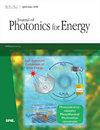CIGS和CZTSSe薄膜太阳能电池中缺陷密度、少数载流子寿命、掺杂密度和吸收层厚度的影响
IF 2.1
4区 工程技术
Q4 MATERIALS SCIENCE, MULTIDISCIPLINARY
引用次数: 0
摘要
摘要对具有由CIGS或CZTSSe制成的均匀光子吸收层的薄膜光伏太阳能电池(PVSC)进行了详细的光电子模拟,以确定缺陷密度、少数载流子寿命、掺杂密度、成分(即带隙能量)和吸收层厚度对太阳能电池性能的影响。采用转移矩阵法计算电子-空穴对(EHP)的产生率,并采用一维漂移扩散模型确定EHP的复合率、开路电压、短路电流密度、功率转换效率和填充因子。通过对有限的实验数据和模拟结果的比较,我们用CIGS或CZTSSe的组成参数公式化了缺陷密度的表达式。薄膜PVSC的所有性能参数由此被证明可以从半导体的体材料响应参数中获得,表面缺陷的影响小到可以忽略。此外,缺陷密度的不切实际的值(相当于少数载流子寿命)将提供对太阳能电池性能的不可靠预测。导出的表达式应指导其他研究人员模拟分级带隙和基于量子阱的PVSC。本文章由计算机程序翻译,如有差异,请以英文原文为准。
Effects of defect density, minority carrier lifetime, doping density, and absorber-layer thickness in CIGS and CZTSSe thin-film solar cells
Abstract. Detailed optoelectronic simulations of thin-film photovoltaic solar cells (PVSCs) with a homogeneous photon-absorber layer made of with CIGS or CZTSSe were carried out to determine the effects of defect density, minority carrier lifetime, doping density, composition (i.e., bandgap energy), and absorber-layer thickness on solar-cell performance. The transfer-matrix method was used to calculate the electron-hole-pair (EHP) generation rate, and a one-dimensional drift-diffusion model was used to determine the EHP recombination rate, open-circuit voltage, short-circuit current density, power-conversion efficiency, and fill factor. Through a comparison of limited experimental data and simulation results, we formulated expressions for the defect density in terms of the composition parameter of either CIGS or CZTSSe. All performance parameters of the thin-films PVSCs were thereby shown to be obtainable from the bulk material-response parameters of the semiconductor, with the influence of surface defects being small enough to be ignored. Furthermore, unrealistic values of the defect density (equivalently, minority carrier lifetime) will deliver unreliable predictions of the solar-cell performance. The derived expressions should guide fellow researchers in simulating the graded-bandgap and quantum-well-based PVSCs.
求助全文
通过发布文献求助,成功后即可免费获取论文全文。
去求助
来源期刊

Journal of Photonics for Energy
MATERIALS SCIENCE, MULTIDISCIPLINARY-OPTICS
CiteScore
3.20
自引率
5.90%
发文量
28
审稿时长
>12 weeks
期刊介绍:
The Journal of Photonics for Energy publishes peer-reviewed papers covering fundamental and applied research areas focused on the applications of photonics for renewable energy harvesting, conversion, storage, distribution, monitoring, consumption, and efficient usage.
 求助内容:
求助内容: 应助结果提醒方式:
应助结果提醒方式:


